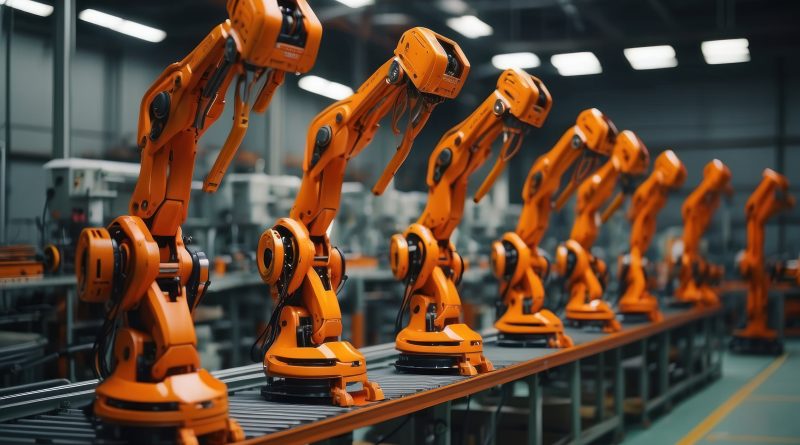Pioneering Advanced Manufacturing in Defense Technology
Technological sophistication is paramount, the defense sector is increasingly relying on advanced manufacturing techniques to meet the high demands of modern warfare. Central to this technological frontier is EOS Defense Systems, a company renowned for its innovative approach to the development and production of counter-drone technologies. As drones become a staple in both military strategy and security operations, the ability to counteract these aerial threats is crucial. EOS stands at the forefront of this challenge, not only by designing effective countermeasures but also by pioneering manufacturing processes that enhance the functionality and reliability of their systems.
EOS Defense Systems’ integration of cutting-edge manufacturing technologies and methodologies significantly impacts the defense industry. Leveraging automated systems, precision engineering, and advanced material science, EOS exemplifies how modern manufacturing can meet complex and critical defense needs efficiently and effectively. This introduction into the world of defense manufacturing not only sets the stage for a discussion on the specific processes involved but also highlights the broader implications for global security and technological advancement.
Manufacturing Excellence: Production of the R600 Remote Weapon Station
At the heart of EOS Defense Systems’ manufacturing prowess is the production of the R600 Remote Weapon Station. This advanced piece of military hardware represents a convergence of diverse technologies and manufacturing disciplines, crafted to deliver unmatched operational performance. The R600 is equipped with a Northrop Grumman M230LF cannon, a coaxial machine gun, and the capability to deploy Javelin missiles, making it a formidable tool against both aerial and ground threats.
The manufacturing process of the R600 Remote Weapon Station is a testament to EOS’s commitment to quality and precision. Utilizing state-of-the-art machining centers, the company ensures that each component of the R600 meets stringent tolerances that are critical for the reliability and functionality of the weapon system. High-strength alloys and composites are used to construct the frame and moving parts of the R600, providing durability while maintaining a weight that is manageable for the mobile platforms it is mounted on.
Innovation in Production: EOS’s Technological Edge
EOS Defense Systems not only leads in the design of counter-drone technologies but also in the adoption of innovative production techniques that set industry standards. At the core of EOS’s manufacturing strategy is the integration of advanced robotics and artificial intelligence within their production lines. These technologies facilitate a level of precision and efficiency that traditional manufacturing methods cannot match, allowing EOS to produce highly reliable and sophisticated defense systems.
For instance, EOS employs automated machining centers capable of operating 24/7 with minimal human supervision, thus significantly reducing production times and increasing output rates. These centers utilize real-time data analytics to optimize the machining process, adjusting parameters instantly for variations in material properties or tool wear. This adaptability ensures that each part of the R600 Remote Weapon Station is manufactured to the highest standards.
The manufacturing prowess of EOS Defense Systems extends beyond production techniques to encompass strategic supply chain management and scalability. Effective supply chain integration is crucial for meeting the rigorous demands of defense manufacturing, involving tight deadlines and the need for high reliability under combat conditions. EOS excels in this area by implementing a streamlined supply chain that emphasizes both speed and quality, ensuring that all components meet the necessary specifications for defense applications.
EOS’s supply chain strategy includes partnerships with trusted suppliers who can provide high-quality materials and components quickly and reliably. This network enables EOS to scale production efficiently to meet sudden increases in demand without compromising on quality. Additionally, the company’s strategic locations near major transportation hubs facilitate quick distribution of their defense systems to global markets, enhancing their ability to respond swiftly to international needs.
The Future of Defense Manufacturing: Trends and Predictions
As we look toward the future, the defense manufacturing sector is poised for significant transformation, influenced by rapid advancements in technology and shifting global security needs. EOS Defense Systems is at the vanguard of this evolution, continuously exploring new technologies and methodologies to enhance their manufacturing capabilities. The future of defense manufacturing is likely to be characterized by a greater emphasis on sustainability, automation, and the integration of artificial intelligence (AI) in production processes.
Sustainability is becoming a crucial factor in defense manufacturing. With increasing global focus on environmental impacts, defense companies like EOS are seeking ways to minimize their carbon footprint while maintaining production efficiency. This includes the use of environmentally friendly materials, energy-efficient production technologies, and recycling systems that reduce waste. By integrating these practices, EOS not only contributes to environmental conservation but also aligns with global standards and regulations that prioritize sustainability.
The role of automation and AI in defense manufacturing is set to expand significantly. EOS is already leveraging these technologies, but future developments could see AI taking a more central role in predictive maintenance, quality control, and even in the autonomous assembly processes. This shift will likely increase the precision and efficiency of manufacturing operations while reducing the potential for human error, thereby enhancing the overall reliability of defense products.
As conflicts become more asymmetric and varied, there is a growing demand for customized defense solutions tailored to specific scenarios and environments. EOS is positioned to meet this demand through advanced manufacturing techniques like 3D printing, which allows for rapid prototyping and customization of parts. This capability not only speeds up the production process but also enables the creation of equipment that is specifically designed to meet the unique needs of different defense forces.
The global nature of defense challenges encourages the formation of international partnerships in manufacturing. EOS could expand its global footprint by collaborating with other leading defense manufacturers to combine expertise, resources, and technologies. These collaborations might focus on co-developing new technologies or setting up joint manufacturing facilities in strategic locations, enhancing the ability to serve international markets more effectively.
